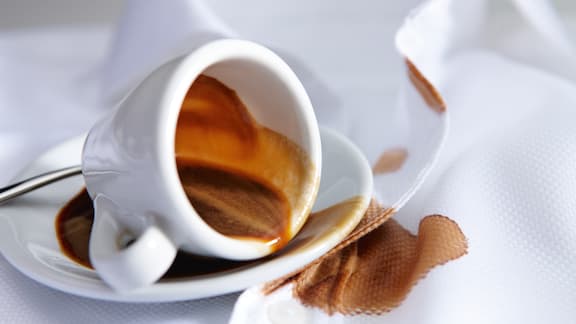When crockery discolours
Dishwashing is finished but sometimes users come in for a surprise when their crockery comes out stained. At fault are foodstuffs such as tomato sauce, vegetables, tea or coffee which leave behind in part very stubborn stains.

Why does crockery discolours?
The type and state of food has a huge impact on discolouration.
A further major role is played by:
- Exposure time
- Temperature of food
- The material and condition of the load. Even the seemingly smooth and intact surfaces of plastics or porcelain are susceptible to discolouration.
Why and how is crockery damaged?
If discolouration is only superficial, it can generally be treated and removed by further washing. If, however, surfaces are damaged, stains become more difficult to remove. Such damage occurs during everyday use when, for example, knives and forks scratch surfaces or crockery is stacked.
How can stains be removed?
One tried-and-tested way of removing for instance brownish stains on coffee cups is bleaching. This involves the use of a detergent containing a bleaching agent, typically active chlorine or active oxygen. Bleaching oxidises pigments during the wash cycle, rendering discolouration 'invisible' in the process.
Why are plastics particularly difficult cases?
On plastics, even bleach often does not have the desired effect. One reason for this is the chemical structure of plastics: They consist of countless chains of carbon molecules. Pigments from foodstuffs adsorb onto the surfaces of this structure permanently, making their removal a difficult task. If the surface has fissures or scratches, pigments diffuse with ease deeper into the material. Once ingress has occurred, pigments cannot be removed either chemically or mechanically. These stains are permanent and no end of scrubbing or bleaching will help.
How can discolouration be avoided?
In order to avoid discolouration in the first place, crockery soiled with food and drinks which are rich in pigments should be rinsed briefly immediately after use. Coarse food residue should also be removed to prevent it from drying on. Beware: A plate with tomato ketchup placed in the dishwasher can result in pigments being released and redepositing on other load items, once again causing discolouration.
Summary
Foodstuffs such as tomato sauce not only cause stubborn stains on tablecloths; they are also often the cause of the unsightly discolouration of plastics. In both cases, the same applies: Stains are annoying but not necessarily irremovable. By acting promptly and using the correct means, customers can be assured many years of pleasure with their tablecloths – and their crockery.